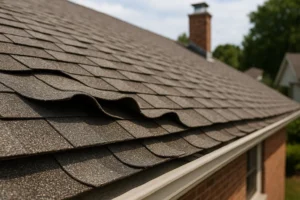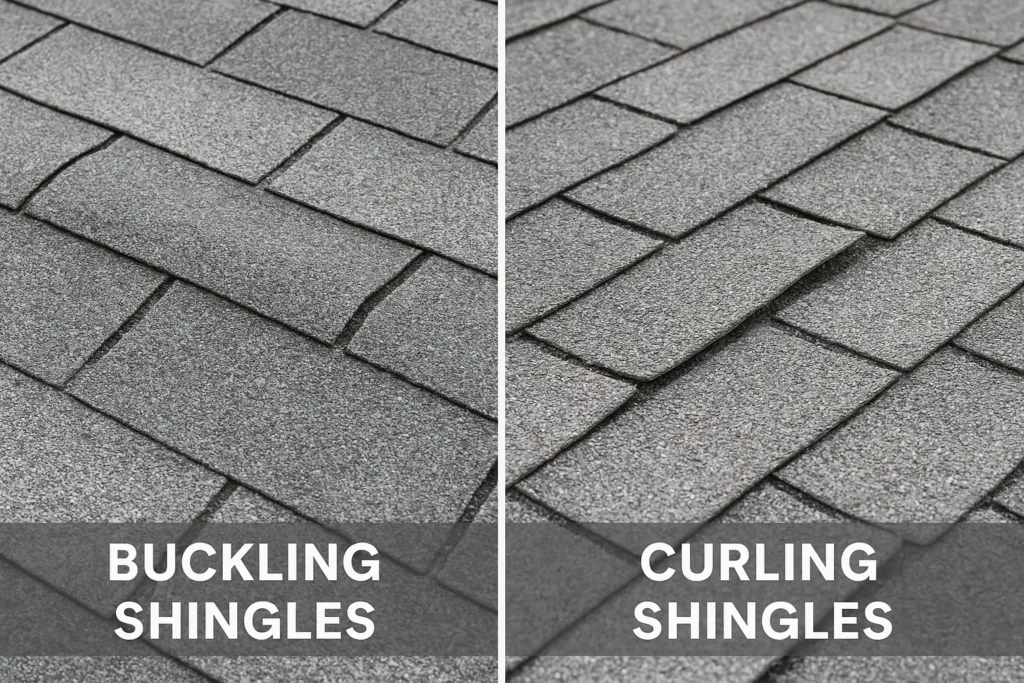Curling vs. Buckling Shingles: Causes, Fixes, and When to Call a Roofer in Phoenix

Most roofing problems don’t start with a major leak. Instead, they appear slowly — a lifted edge here, a ripple across the roof there. Curling and buckling shingles are two of the earliest warning signs homeowners can spot. Left untreated, these small issues can grow into full-blown roof failures, especially under Arizona’s punishing sun and sudden monsoon storms.
If you’ve noticed curling shingles on your roof or visible buckles running across a slope, it’s time to take a closer look. This guide explains what curling and buckling really mean, what causes them, and when to call for a professional.
Curling vs. Buckling — What’s the Difference?
At first glance, curling and buckling shingles may look similar, but they have different causes and implications:
- Curling shingles: The edges of shingles turn upward, sometimes exposing the underside. This often happens as shingles lose oils and flexibility from years of UV exposure. In Phoenix, where roof surfaces can reach 160°F in summer, curling shows up much sooner than in cooler climates.
- Buckling shingles: Buckling looks like long ripples or raised ridges running vertically or diagonally across the roof. This suggests a problem beneath the surface — often with underlayment, decking, or trapped moisture.
In short: Curling is usually age and heat related, while buckling is often linked to moisture or installation errors.
What Causes Shingles to Buckle or Curl?
1. Moisture trapped in the roof system
When roof decking or underlayment absorbs moisture, it swells. As it dries, it contracts. This movement “telegraphs” through the shingles, creating visible buckles. In Arizona, sudden monsoon downpours can soak underlayment if shingles are installed before the deck has dried completely.
2. Poor attic ventilation
Poor ventilation traps heat and humidity in the attic. In Phoenix summers, attic temperatures often exceed 150°F, which warps the roof deck and accelerates curling and buckling. Balanced intake and exhaust vents are critical for protecting shingles.
3. Improper installation
Installing shingles over wet or wrinkled underlayment is one of the most common reasons for new roof buckling. Overlays — installing new shingles over old ones — also create uneven pressure points that lead to curling or buckling.
4. Climate stress
Arizona’s climate is harsh on shingles. Long periods of extreme sun followed by sudden moisture loads during monsoon season create expansion-contraction cycles that wear shingles down faster than in most other regions.
5. Material aging
Over time, shingles lose their flexibility and natural oils. This makes the edges brittle and prone to curling. In Phoenix, most asphalt shingles last 15–20 years at most before curling begins.
Why Do Shingles Buckle on a New Roof?
It’s surprising when a roof less than a year old starts showing waves or buckles, but it happens. The causes are almost always linked to errors or overlooked conditions at installation:
- Shingling over damp underlayment during Arizona’s monsoon season.
- Designing the roof without proper attic ventilation.
- Skipping a full tear-off and laying new shingles over old ones.
These problems don’t resolve on their own. If you’re seeing new roof buckling shingles, call a professional immediately. At The Roofing Company, our crews never install shingles over wet materials and always confirm proper ventilation before laying shingles.
How to Fix Buckling or Curling Shingles
The repair approach depends on the root cause and severity:
- Localized repair: Replace individual shingles and flatten wrinkled underlayment.
- Underlayment correction: Replace sections of damp or poorly installed underlayment.
- Ventilation upgrades: Add balanced intake (soffit vents) and exhaust (ridge vents).
- Deck repair: Replace warped or moisture-damaged decking panels.
- Full replacement: When curling or buckling covers large areas, replacement is usually the smarter long-term solution.
Our Glendale roof repair specialists and Mesa roofing experts can inspect and determine whether you need a small repair or full roof replacement in Scottsdale.
Phoenix Heat & Monsoon Risks
Neighborhoods like Arcadia, Ahwatukee, Desert Ridge, and Glendale experience some of the toughest roofing conditions:
- Heat aging: Constant sun exposure dries out shingles, causing curling.
- Monsoon spikes: Sudden humidity saturates underlayment, leading to buckling.
- Dust storms: High winds push dirt and debris under curled edges, worsening damage.
We recommend annual inspections — once in spring before monsoon season and again in fall after storms have passed.
Repair or Replace? A Homeowner’s Guide
When deciding whether to repair or replace, consider:
- Scope: Is the problem isolated or widespread?
- Age: Curling on a 5-year-old roof may be repairable. Curling on a 20-year-old roof usually means it’s time for replacement.
- Ventilation: Has attic airflow been checked? Correcting ventilation may solve the root cause.
Our inspections in Glendale, Mesa, and Scottsdale provide the details you need to make the right choice.
Frequently Asked Questions
What causes roof shingles to buckle?
Shingles buckle when moisture is trapped in decking or underlayment, attic ventilation is poor, or shingles are improperly installed.
Why are my shingles curling up at the edges?
Shingles curl at the edges from prolonged UV exposure, trapped attic heat, or natural material fatigue.
Why do shingles buckle on a new roof?
Even new roofs can buckle if installed over wet underlayment or without adequate ventilation.
How can I fix buckling or curling shingles?
Localized replacement and ventilation upgrades may help. Widespread issues often require full replacement.
Do curling and buckling shingles always mean I need a roof replacement?
Not always. If isolated and the roof is fairly new, repairs may be possible. But widespread problems on older roofs usually require replacement.
Conclusion
Curling and buckling shingles aren’t just cosmetic. They’re signs of roof stress that will only worsen under Arizona’s heat and monsoon storms. If you see these problems on your home, don’t wait until leaks appear. Call The Roofing Company today for a professional inspection:


